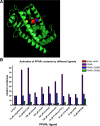A functional peroxisome proliferator-activated receptor-gamma ligand-binding domain is not required for adipogenesis
- PMID: 18622018
- PMCID: PMC2529017
- DOI: 10.1074/jbc.C800139200
A functional peroxisome proliferator-activated receptor-gamma ligand-binding domain is not required for adipogenesis
Abstract
The nuclear hormone receptor peroxisome proliferator-activated receptor-gamma (PPARgamma) is the central regulator of adipogenesis. Although it is the target for several drugs that function as agonist activators, a high affinity endogenous ligand for this receptor that is involved in regulating adipogenesis has yet to be identified. Here, we investigated the requirement for ligand activation of PPARgamma in fat cell differentiation, taking advantage of a natural mutant of this receptor that does not bind or become activated by any known natural or synthetic ligand. When ectopically expressed in PPARgamma-null fibroblasts, this Q286P allele was able to strongly promote morphological adipogenesis, without any significant difference compared with wild-type PPARgamma. In addition, no significant differences were found in the expression of several adipogenic genes between the wild-type and Q286P mutant alleles. To extend our studies to an in vivo setting, we performed subcutaneous injections of PPARgamma-expressing fibroblasts into nude mice. We found that both wild-type and Q286P mutant-expressing fibroblasts were able to generate fat pads in the mice. These results suggest that the binding and activation of PPARgamma by agonist ligands may not be required for adipogenesis under physiological conditions.
Figures


Similar articles
-
Activation of CCAAT/enhancer-binding protein (C/EBP) alpha expression by C/EBP beta during adipogenesis requires a peroxisome proliferator-activated receptor-gamma-associated repression of HDAC1 at the C/ebp alpha gene promoter.J Biol Chem. 2006 Mar 24;281(12):7960-7. doi: 10.1074/jbc.M510682200. Epub 2006 Jan 23. J Biol Chem. 2006. PMID: 16431920
-
Mechanisms of divergent effects of activated peroxisome proliferator-activated receptor-γ on mitochondrial citrate carrier expression in 3T3-L1 fibroblasts and mature adipocytes.Biochim Biophys Acta. 2013 Jun;1831(6):1027-36. doi: 10.1016/j.bbalip.2013.01.014. Epub 2013 Jan 28. Biochim Biophys Acta. 2013. PMID: 23370576
-
Regulating the balance between peroxisome proliferator-activated receptor gamma and beta-catenin signaling during adipogenesis. A glycogen synthase kinase 3beta phosphorylation-defective mutant of beta-catenin inhibits expression of a subset of adipogenic genes.J Biol Chem. 2004 Oct 22;279(43):45020-7. doi: 10.1074/jbc.M407050200. Epub 2004 Aug 10. J Biol Chem. 2004. PMID: 15308623
-
PPARγ and the global map of adipogenesis and beyond.Trends Endocrinol Metab. 2014 Jun;25(6):293-302. doi: 10.1016/j.tem.2014.04.001. Epub 2014 Apr 29. Trends Endocrinol Metab. 2014. PMID: 24793638 Free PMC article. Review.
-
The global perspective on peroxisome proliferator-activated receptor γ (PPARγ) in ectopic fat deposition: A review.Int J Biol Macromol. 2023 Dec 31;253(Pt 5):127042. doi: 10.1016/j.ijbiomac.2023.127042. Epub 2023 Sep 22. Int J Biol Macromol. 2023. PMID: 37742894 Review.
Cited by
-
Endocrine-disrupting Chemicals: Review of Toxicological Mechanisms Using Molecular Pathway Analysis.J Cancer Prev. 2015 Mar;20(1):12-24. doi: 10.15430/JCP.2015.20.1.12. J Cancer Prev. 2015. PMID: 25853100 Free PMC article. Review.
-
Contribution of Adipose-Derived Factor D/Adipsin to Complement Alternative Pathway Activation: Lessons from Lipodystrophy.J Immunol. 2018 Apr 15;200(8):2786-2797. doi: 10.4049/jimmunol.1701668. Epub 2018 Mar 12. J Immunol. 2018. PMID: 29531168 Free PMC article.
-
Bladder-cancer-associated mutations in RXRA activate peroxisome proliferator-activated receptors to drive urothelial proliferation.Elife. 2017 Nov 16;6:e30862. doi: 10.7554/eLife.30862. Elife. 2017. PMID: 29143738 Free PMC article.
-
Bisphenol a: A narrative review of prenatal exposure effects on adipogenesis and childhood obesity via peroxisome proliferator-activated receptor gamma.Environ Res. 2019 Jun;173:54-68. doi: 10.1016/j.envres.2019.03.012. Epub 2019 Mar 6. Environ Res. 2019. PMID: 30897403 Free PMC article. Review.
-
Liver fatty acid binding protein gene ablation enhances age-dependent weight gain in male mice.Mol Cell Biochem. 2009 Apr;324(1-2):101-15. doi: 10.1007/s11010-008-9989-9. Epub 2008 Dec 23. Mol Cell Biochem. 2009. PMID: 19104910 Free PMC article.
References
-
- Feige, J. N., Gelman, L., Michalik, L., Desvergne, B., and Wahli, W. (2006) Prog. Lipid Res. 45 120–159 - PubMed
-
- Tontonoz, P., Hu, E., Graves, R. A., Budavari, A. I., and Spiegelman, B. M. (1994) Genes Dev. 8 1224–1234 - PubMed
-
- Tontonoz, P., Hu, E., and Spiegelman, B. M. (1994) Cell 79 1147–1156 - PubMed
Publication types
MeSH terms
Substances
Grants and funding
LinkOut - more resources
Full Text Sources
Other Literature Sources

